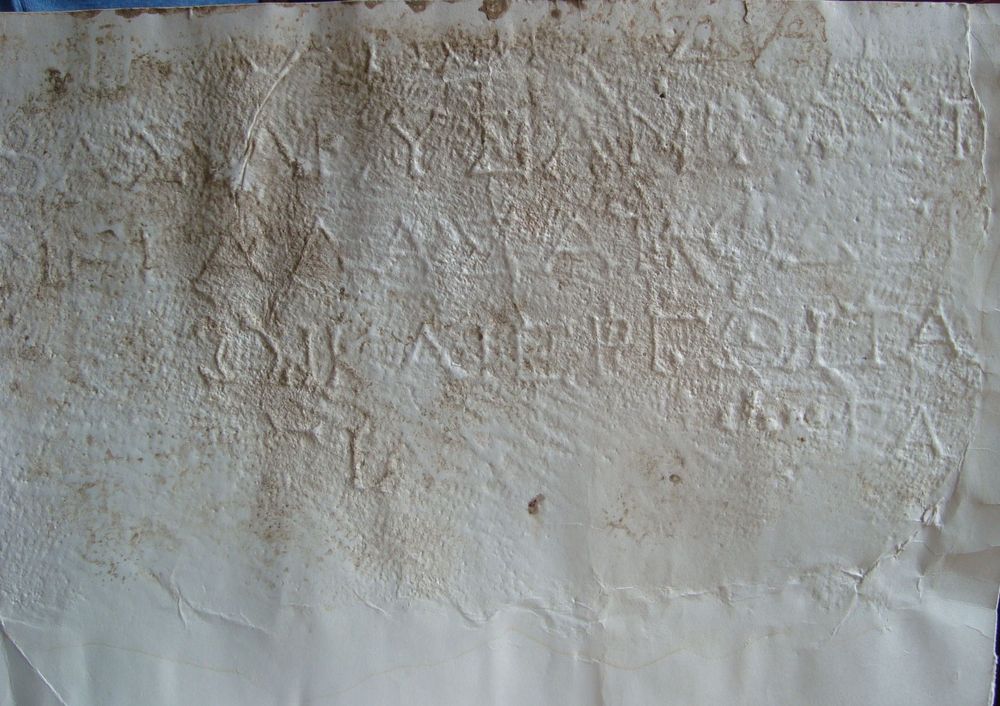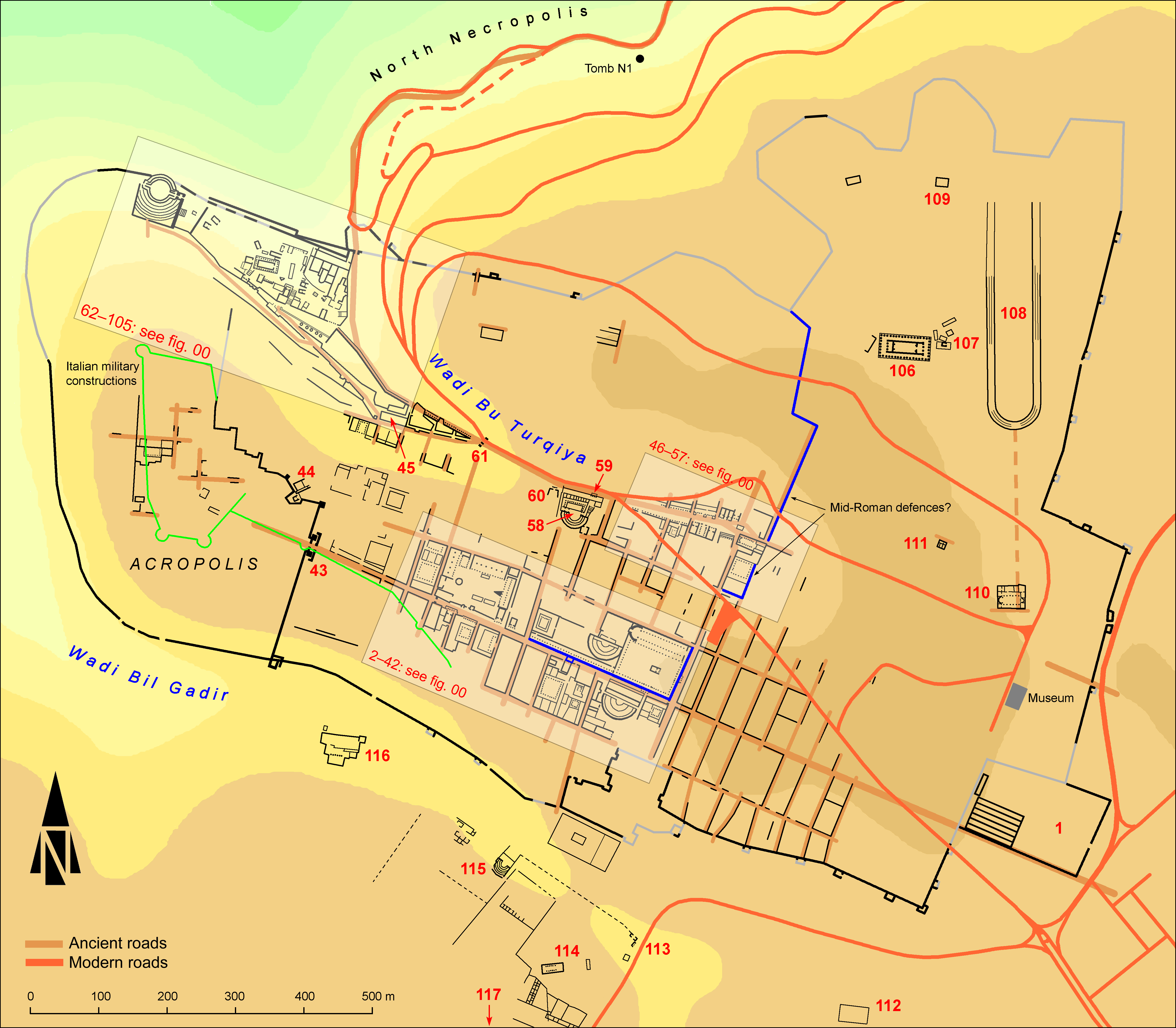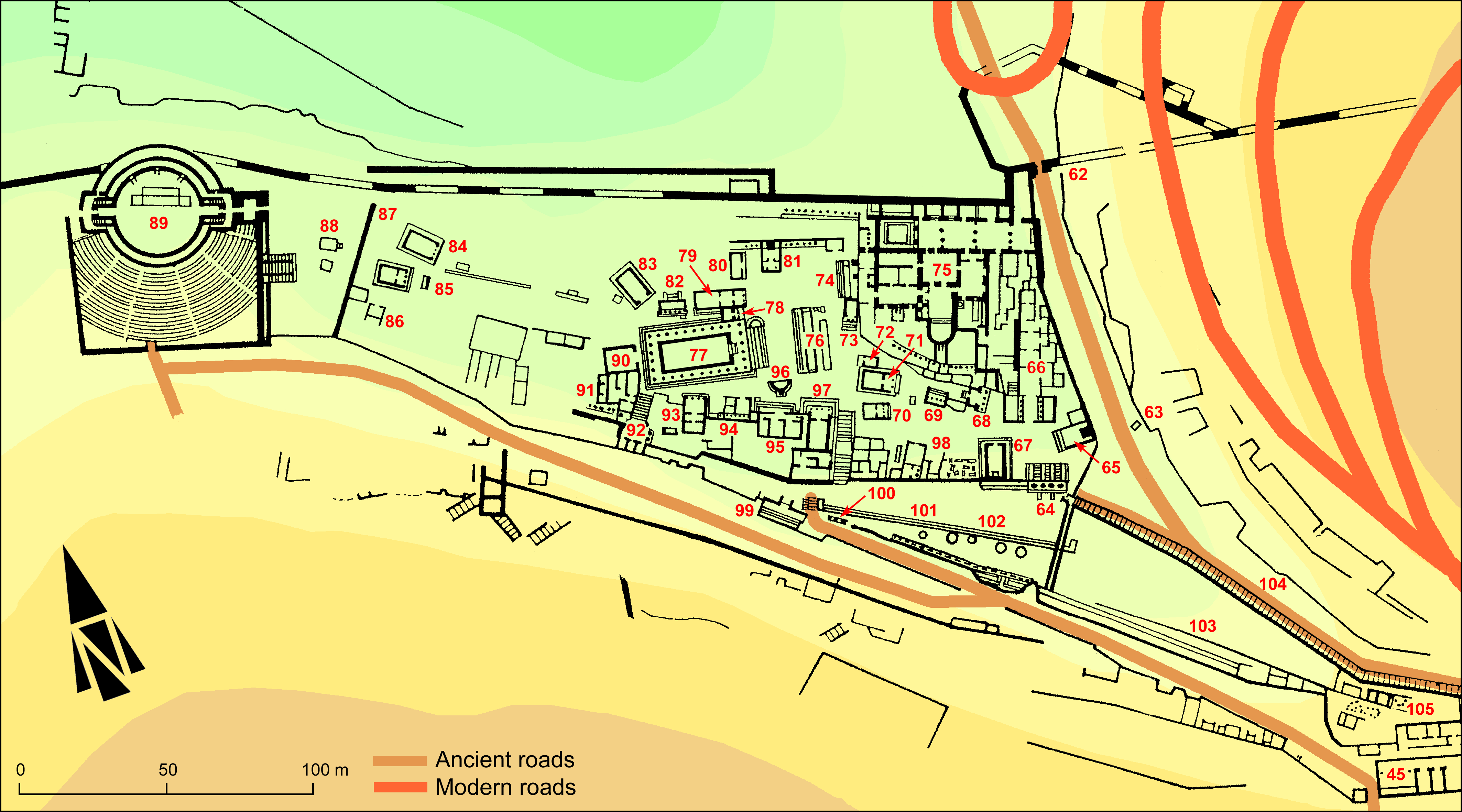EpiDoc XML:
IGCyr1041002
Trismegistos ID:
738563
Source description
Support: White marble, plain rectangular base; the base was later reused twice : 1) upside down for a statue with two footholes on the upper face; 2) recut so that the footholes are at the edge of the new block and a part of the first inscription is lost; on the upper side of the preserved part, there is a large and deep hole for attachment (w: 0.418 × h: 0.256 × d: 0.66).
Layout: Inscribed on front face.
Letters: 0.022; light serifs, alpha with rather low bar, beta with larger lower loop, kappa with long oblique bars, non slanting sigma.
Date: Between 107 and 75 BC (reign).
Findspot: Found in 1934 by G. Oliverio at Cyrene ➚: Sanctuary of Apollo, South of the Temple of Apollo and West of the Grotto of the Priests.
Place of origin: Findspot.
Last recorded location: Seen by D. Morelli in 1960 in the Sanctuary of Apollo, with a very confusing description of the exact place, but probably at findspot. Seen at findspot by L. Gasperini in 1972, with amended description of the place inside the Sanctuary of Apollo. Observed in 2004 by C. Dobias-Lalou at the same place.
Text constituted from: Transcription from stone (CDL).
Bibliography
Morelli in SECir, 246 (no image); Van't Dack in Hauben – Van't Dack 1971, p. 35 and Habicht 1972, pp. 127-128, whence Robert, BE, 1972.620-621; Reynolds in Vickers – Reynolds 1971-1972, p. 44; Laronde 1987, pp. 421-422, 455, whence SEG, 38.1885; Gasperini 1996, pp. 149-154 (ph.; dr.) (=Gasperini – Arnaldi – Marengo 2008, pp. 370-380), whence SEG, 46.2202; IGCyr 104100 ➚. Cf. Fraser 1972 vol. II, p. 189, footnote 81; Mooren 1975, n. 0407; Bagnall 1976, pp. 36-37; Criscuolo 2011, pp. 139-140; Rosamilia 2023, p. 38, footnote 178.
Text
Apparatus
1: Αἰγλάνορα Gasperini 1996: Αἰγλάνωρα SECir || Δαμ[ατρίω, τὸν συνγενῆ τῶ] Laronde 1987, Gasperini 1996: Δαμα[---] SECir
2: Π[τολεμαίω, πολλὰς καὶ] Gasperini 1996: Π[τολεμαίω ---] SECir; ἁ̣[μῶν Πτολεμαίω] Hauben – Van't Dack 1971, Laronde 1987
3: ἀποδεί[ξιας]: ἀποδεί[ξεις] SECir
4: λ̣ό̣γωι Hauben – Van't Dack 1971, Vickers – Reynolds 1971-1972 independently: ἄθλωι SECir || τᾶ[ς ποθ’ ἑαυτὸς]: τᾶ[ς ποθ’ ἑαυτοὺς] Gasperini 1996; τᾶ[ς ποθ’ αὑτοὺς] SECir; τᾶ[ς εὐνοίας ἕνεκα καὶ] Laronde 1987
5: Κυραν̣[αῖοι (vac. 2) ἀνέθηκαν]: Κυραν̣[αῖοι ---] SECir; Κυραν̣[αῖοι (vac.)] Gasperini 1996
French translation
(scil. La statue) d'Aiglanor fils de Damatrios, Parent de Ptolémée qui fut notre roi, pour les nombreuses grandes démonstrations qu'il a faites en paroles et en actes de son affection envers eux [a été consacrée], par les Cyrénéens.
English translation
(scil. The statue) of Aiglanor son of Damatrios, Akin to Ptolemy once our king, on behalf of the many great demonstrations in deeds and in words of his love towards themselves, [was dedicated] by the Cyrenaeans.
Italian translation
(scil. La statua) di Aiglanor figlio di Damatrios, Parente di Tolemeo che è stato nostro re, in considerazione delle molte dimostrazioni con le parole e con i fatti del suo affetto nei loro confronti, [è stata dedicata] dai Cirenei.
Arabic translation
(تمثال) إيجلانور بن داماتريوس، قريب ملكنا بطليموس، لأجل ظهوره أو مشاركته اللافته في العديد من الاعمال العظيمة ولكلماته المحبه لهم، [أهدي] (هذا التمثال .له) من قبل الكيرينيين
Commentary
Morelli and Reynolds had seen the stone in the right position for someone reading this inscription. Later on, Gasperini found the stone and described it as having been used twice. He supposed that a similar block had stood at right of this side. However his description is somewhat confusing as to the different sides and the caption of his figure 5 is erroneous. Dobias-Lalou now thinks that there were three successive phases, as described above.
This dedication is very similar to IGCyr0650002 and has been restored as fully parallel by Laronde who had not found the stone. However, Gasperini has shown that there were some substantial differences.
The common problem of both inscriptions is the exact meaning of the aorist participle βασιλεύσαντος: it might refer either to a dead king (Ptolemy IX Soter II or the discussed Ptolemy Apion) or to a king who no longer reigned over Cyrenaica (Ptolemy IX Soter II, after he flew to Cyprus in 107 BC). It might also be Ptolemy VIII, as shown by Criscuolo. See commentary at IGCyr0650002
About the discovery of the stone see the report now published by Luni 2014, p. 141, which confirms that the stone was found at the very place where Gasperini and Dobias-Lalou saw it later.
CC BY-NC-SA 4.0 Deed Attribution-NonCommercial-ShareAlike 4.0 International License.
All citation, reuse or distribution of this work must contain a link back to DOI: https://doi.org/10.60760/unibo/igcyrgvcyr2 and the filename (IGCyr000000 or GVCyr000), as well as the year of consultation.




